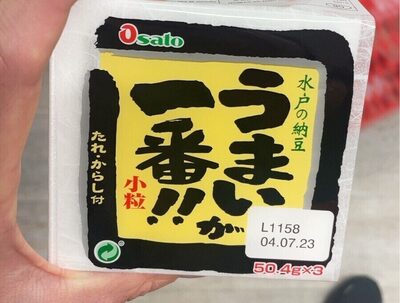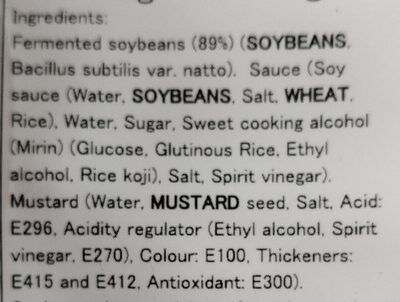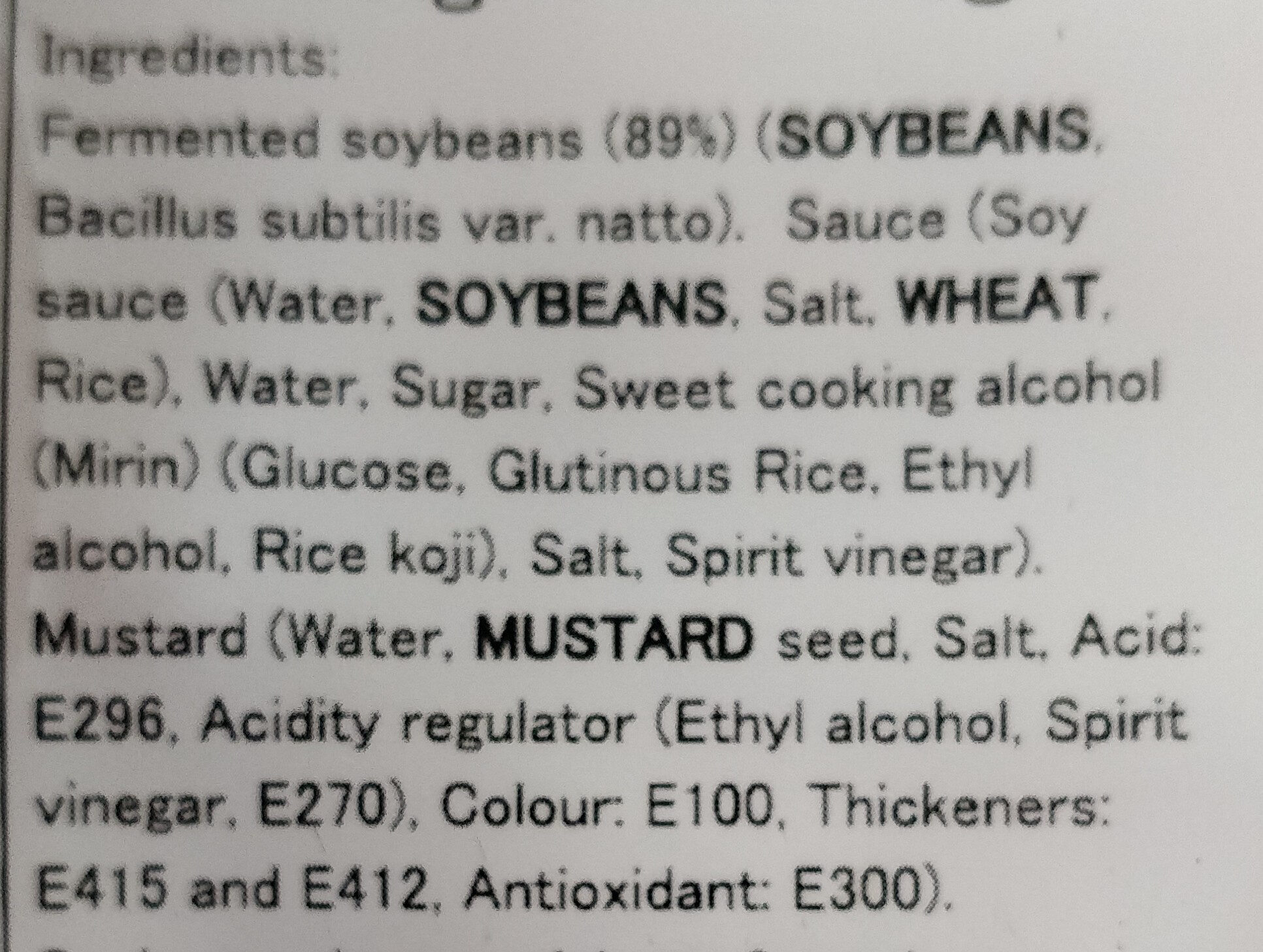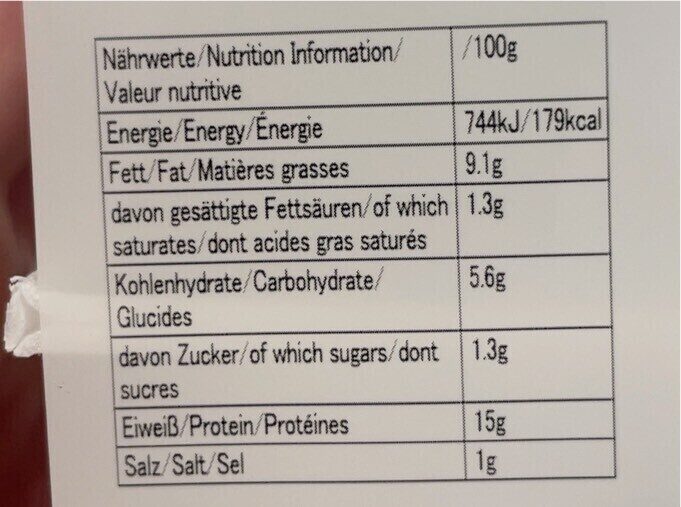Help us make food transparency the norm!
As a non-profit organization, we depend on your donations to continue informing consumers around the world about what they eat.
The food revolution starts with you!
Natto - Osato
Natto - Osato
This product page is not complete. You can help to complete it by editing it and adding more data from the photos we have, or by taking more photos using the app for Android or iPhone/iPad. Thank you!
×
Barcode: 4970457000013 (EAN / EAN-13)
Packaging: Plastic, Ps-polystyrene, Plastic film
Brands: Osato
Categories: Plant-based foods and beverages, Fermented foods, Plant-based foods, Legumes and their products, Legumes, Seeds, Legume seeds, Soy beans
Labels, certifications, awards: Nattō
Origin of ingredients: Japan
Manufacturing or processing places: Japan
Stores: Oriental Mart
Countries where sold: United Kingdom
Matching with your preferences
Health
Ingredients
-
37 ingredients
Fermented soybeans (89%) (SOYBEANS Bacillus subtilis var. natto). Sauce (Soy sauce (Water, SOYBEANS. Salt, WHEAT. Rice), Water, Sugar, Sweet cooking alcohol (Mirin) (Glucose, Glutinous Rice, Ethyl alcohol, Rice koji), Sait, Spirit vinegar). Mustard (Water, MUSTARD seed, Salt. Acid: E296, Acidity regulator (Ethyl alcohol, Spirit vinegar, E270), Colour: E100, Thickeners: E415 and E412, Antioxidant: E300).Allergens: Gluten, Mustard, SoybeansTraces: Gluten, Mustard, Soybeans
Food processing
-
Ultra processed foods
Elements that indicate the product is in the 4 - Ultra processed food and drink products group:
- Additive: E100 - Curcumin
- Additive: E412 - Guar gum
- Additive: E415 - Xanthan gum
- Ingredient: Colour
- Ingredient: Glucose
- Ingredient: Thickener
Food products are classified into 4 groups according to their degree of processing:
- Unprocessed or minimally processed foods
- Processed culinary ingredients
- Processed foods
- Ultra processed foods
The determination of the group is based on the category of the product and on the ingredients it contains.
Additives
-
E1510 - Ethanol
Ethanol: Ethanol, also called alcohol, ethyl alcohol, grain alcohol, and drinking alcohol, is a chemical compound, a simple alcohol with the chemical formula C2H5OH. Its formula can be also written as CH3−CH2−OH or C2H5−OH -an ethyl group linked to a hydroxyl group-, and is often abbreviated as EtOH. Ethanol is a volatile, flammable, colorless liquid with a slight characteristic odor. It is a psychoactive substance and is the principal type of alcohol found in alcoholic drinks. Ethanol is naturally produced by the fermentation of sugars by yeasts or via petrochemical processes, and is most commonly consumed as a popular recreational drug. It also has medical applications as an antiseptic and disinfectant. The compound is widely used as a chemical solvent, either for scientific chemical testing or in synthesis of other organic compounds, and is a vital substance used across many different kinds of manufacturing industries. Ethanol is also used as a clean-burning fuel source.Source: Wikipedia
-
E270 - Lactic acid
Lactic acid: Lactic acid is an organic compound with the formula CH3CH-OH-COOH. In its solid state, it is white and water-soluble. In its liquid state, it is colorless. It is produced both naturally and synthetically. With a hydroxyl group adjacent to the carboxyl group, lactic acid is classified as an alpha-hydroxy acid -AHA-. In the form of its conjugate base called lactate, it plays a role in several biochemical processes. In solution, it can ionize a proton from the carboxyl group, producing the lactate ion CH3CH-OH-CO−2. Compared to acetic acid, its pKa is 1 unit less, meaning lactic acid deprotonates ten times more easily than acetic acid does. This higher acidity is the consequence of the intramolecular hydrogen bonding between the α-hydroxyl and the carboxylate group. Lactic acid is chiral, consisting of two optical isomers. One is known as L--+--lactic acid or -S--lactic acid and the other, its mirror image, is D--−--lactic acid or -R--lactic acid. A mixture of the two in equal amounts is called DL-lactic acid, or racemic lactic acid. Lactic acid is hygroscopic. DL-lactic acid is miscible with water and with ethanol above its melting point which is around 17 or 18 °C. D-lactic acid and L-lactic acid have a higher melting point. In animals, L-lactate is constantly produced from pyruvate via the enzyme lactate dehydrogenase -LDH- in a process of fermentation during normal metabolism and exercise. It does not increase in concentration until the rate of lactate production exceeds the rate of lactate removal, which is governed by a number of factors, including monocarboxylate transporters, concentration and isoform of LDH, and oxidative capacity of tissues. The concentration of blood lactate is usually 1–2 mM at rest, but can rise to over 20 mM during intense exertion and as high as 25 mM afterward. In addition to other biological roles, L-lactic acid is the primary endogenous agonist of hydroxycarboxylic acid receptor 1 -HCA1-, which is a Gi/o-coupled G protein-coupled receptor -GPCR-.In industry, lactic acid fermentation is performed by lactic acid bacteria, which convert simple carbohydrates such as glucose, sucrose, or galactose to lactic acid. These bacteria can also grow in the mouth; the acid they produce is responsible for the tooth decay known as caries. In medicine, lactate is one of the main components of lactated Ringer's solution and Hartmann's solution. These intravenous fluids consist of sodium and potassium cations along with lactate and chloride anions in solution with distilled water, generally in concentrations isotonic with human blood. It is most commonly used for fluid resuscitation after blood loss due to trauma, surgery, or burns.Source: Wikipedia
-
E296 - Malic acid
Malic acid: Malic acid is an organic compound with the molecular formula C4H6O5. It is a dicarboxylic acid that is made by all living organisms, contributes to the pleasantly sour taste of fruits, and is used as a food additive. Malic acid has two stereoisomeric forms -L- and D-enantiomers-, though only the L-isomer exists naturally. The salts and esters of malic acid are known as malates. The malate anion is an intermediate in the citric acid cycle.Source: Wikipedia
-
E412 - Guar gum
Guar gum (E412) is a natural food additive derived from guar beans.
This white, odorless powder is valued for its remarkable thickening and stabilizing properties, making it a common ingredient in various food products, including sauces, dressings, and ice creams.
When used in moderation, guar gum is considered safe for consumption, with no known adverse health effects.
-
E415 - Xanthan gum
Xanthan gum (E415) is a natural polysaccharide derived from fermented sugars, often used in the food industry as a thickening and stabilizing agent.
This versatile food additive enhances texture and prevents ingredient separation in a wide range of products, including salad dressings, sauces, and gluten-free baked goods.
It is considered safe for consumption even at high intake amounts.
Ingredients analysis
-
Palm oil content unknown
Unrecognized ingredients: Soybeans-bacillus-subtilis-var, Natto, Sweet-cooking-alcohol, SaitSome ingredients could not be recognized.
We need your help!
You can help us recognize more ingredients and better analyze the list of ingredients for this product and others:
- Edit this product page to correct spelling mistakes in the ingredients list, and/or to remove ingredients in other languages and sentences that are not related to the ingredients.
- Add new entries, synonyms or translations to our multilingual lists of ingredients, ingredient processing methods, and labels.
If you would like to help, join the #ingredients channel on our Slack discussion space and/or learn about ingredients analysis on our wiki. Thank you!
-
Vegan status unknown
Unrecognized ingredients: Soybeans-bacillus-subtilis-var, Natto, Sweet-cooking-alcohol, Rice koji, Sait, MustardSome ingredients could not be recognized.
We need your help!
You can help us recognize more ingredients and better analyze the list of ingredients for this product and others:
- Edit this product page to correct spelling mistakes in the ingredients list, and/or to remove ingredients in other languages and sentences that are not related to the ingredients.
- Add new entries, synonyms or translations to our multilingual lists of ingredients, ingredient processing methods, and labels.
If you would like to help, join the #ingredients channel on our Slack discussion space and/or learn about ingredients analysis on our wiki. Thank you!
-
Vegetarian status unknown
Unrecognized ingredients: Soybeans-bacillus-subtilis-var, Natto, Sweet-cooking-alcohol, Rice koji, Sait, MustardSome ingredients could not be recognized.
We need your help!
You can help us recognize more ingredients and better analyze the list of ingredients for this product and others:
- Edit this product page to correct spelling mistakes in the ingredients list, and/or to remove ingredients in other languages and sentences that are not related to the ingredients.
- Add new entries, synonyms or translations to our multilingual lists of ingredients, ingredient processing methods, and labels.
If you would like to help, join the #ingredients channel on our Slack discussion space and/or learn about ingredients analysis on our wiki. Thank you!
-
Details of the analysis of the ingredients
We need your help!
Some ingredients could not be recognized.
We need your help!
You can help us recognize more ingredients and better analyze the list of ingredients for this product and others:
- Edit this product page to correct spelling mistakes in the ingredients list, and/or to remove ingredients in other languages and sentences that are not related to the ingredients.
- Add new entries, synonyms or translations to our multilingual lists of ingredients, ingredient processing methods, and labels.
If you would like to help, join the #ingredients channel on our Slack discussion space and/or learn about ingredients analysis on our wiki. Thank you!
: soybeans 89% (SOYBEANS Bacillus subtilis var, natto), Sauce (Soy sauce (Water, SOYBEANS, Salt, WHEAT, Rice), Water, Sugar, Sweet cooking alcohol (Mirin, Glucose, Glutinous Rice, Ethyl alcohol, Rice koji), Sait, Spirit vinegar), Mustard (Water, MUSTARD seed, Salt, Acid (e296), Acidity regulator (Ethyl alcohol, Spirit vinegar, e270), Colour (e100), Thickeners (e415), e412, Antioxidant (e300))- soybeans -> en:soya-bean - vegan: yes - vegetarian: yes - ciqual_food_code: 20901 - percent_min: 89 - percent: 89 - percent_max: 89
- SOYBEANS Bacillus subtilis var -> en:soybeans-bacillus-subtilis-var - percent_min: 44.5 - percent_max: 89
- natto -> en:natto - percent_min: 0 - percent_max: 44.5
- Sauce -> en:sauce - vegan: maybe - vegetarian: maybe - percent_min: 5.5 - percent_max: 11
- Soy sauce -> en:soy-sauce - vegan: maybe - vegetarian: maybe - ciqual_food_code: 11104 - percent_min: 0.916666666666667 - percent_max: 11
- Water -> en:water - vegan: yes - vegetarian: yes - ciqual_food_code: 18066 - percent_min: 0.183333333333333 - percent_max: 11
- SOYBEANS -> en:soya-bean - vegan: yes - vegetarian: yes - ciqual_food_code: 20901 - percent_min: 0 - percent_max: 5.5
- Salt -> en:salt - vegan: yes - vegetarian: yes - ciqual_food_code: 11058 - percent_min: 0 - percent_max: 1
- WHEAT -> en:wheat - vegan: yes - vegetarian: yes - ciqual_proxy_food_code: 9410 - percent_min: 0 - percent_max: 1
- Rice -> en:rice - vegan: yes - vegetarian: yes - ciqual_proxy_food_code: 9100 - percent_min: 0 - percent_max: 1
- Water -> en:water - vegan: yes - vegetarian: yes - ciqual_food_code: 18066 - percent_min: 0 - percent_max: 5.5
- Sugar -> en:sugar - vegan: yes - vegetarian: yes - ciqual_proxy_food_code: 31016 - percent_min: 0 - percent_max: 1.3
- Sweet cooking alcohol -> en:sweet-cooking-alcohol - percent_min: 0 - percent_max: 1.3
- Mirin -> en:mirin - vegan: maybe - vegetarian: maybe - percent_min: 0 - percent_max: 1.3
- Glucose -> en:glucose - vegan: yes - vegetarian: yes - ciqual_proxy_food_code: 31016 - percent_min: 0 - percent_max: 0.65
- Glutinous Rice -> en:glutinous-rice - vegan: yes - vegetarian: yes - ciqual_proxy_food_code: 9100 - percent_min: 0 - percent_max: 0.433333333333333
- Ethyl alcohol -> en:e1510 - vegan: yes - vegetarian: yes - percent_min: 0 - percent_max: 0.325
- Rice koji -> en:rice-koji - percent_min: 0 - percent_max: 0.26
- Sait -> en:sait - percent_min: 0 - percent_max: 1.3
- Spirit vinegar -> en:spirit-vinegar - vegan: yes - vegetarian: yes - ciqual_food_code: 11018 - percent_min: 0 - percent_max: 1.3
- Soy sauce -> en:soy-sauce - vegan: maybe - vegetarian: maybe - ciqual_food_code: 11104 - percent_min: 0.916666666666667 - percent_max: 11
- Mustard -> en:mustard - ciqual_food_code: 11013 - percent_min: 0 - percent_max: 5.5
- Water -> en:water - vegan: yes - vegetarian: yes - ciqual_food_code: 18066 - percent_min: 0 - percent_max: 5.5
- MUSTARD seed -> en:mustard-seed - vegan: yes - vegetarian: yes - ciqual_food_code: 11013 - percent_min: 0 - percent_max: 2.75
- Salt -> en:salt - vegan: yes - vegetarian: yes - ciqual_food_code: 11058 - percent_min: 0 - percent_max: 1
- Acid -> en:acid - percent_min: 0 - percent_max: 1
- e296 -> en:e296 - vegan: yes - vegetarian: yes - percent_min: 0 - percent_max: 1
- Acidity regulator -> en:acidity-regulator - percent_min: 0 - percent_max: 1
- Ethyl alcohol -> en:e1510 - vegan: yes - vegetarian: yes - percent_min: 0 - percent_max: 1
- Spirit vinegar -> en:spirit-vinegar - vegan: yes - vegetarian: yes - ciqual_food_code: 11018 - percent_min: 0 - percent_max: 0.5
- e270 -> en:e270 - vegan: yes - vegetarian: yes - percent_min: 0 - percent_max: 0.333333333333333
- Colour -> en:colour - percent_min: 0 - percent_max: 1
- e100 -> en:e100 - vegan: yes - vegetarian: yes - percent_min: 0 - percent_max: 1
- Thickeners -> en:thickener - percent_min: 0 - percent_max: 0.785714285714286
- e415 -> en:e415 - vegan: yes - vegetarian: yes - percent_min: 0 - percent_max: 0.785714285714286
- e412 -> en:e412 - vegan: yes - vegetarian: yes - percent_min: 0 - percent_max: 0.6875
- Antioxidant -> en:antioxidant - percent_min: 0 - percent_max: 0.611111111111111
- e300 -> en:e300 - vegan: yes - vegetarian: yes - percent_min: 0 - percent_max: 0.611111111111111
Nutrition
-
Very good nutritional quality
⚠ ️Warning: the amount of fiber is not specified, their possible positive contribution to the grade could not be taken into account.⚠ ️Warning: the amount of fruits, vegetables and nuts is not specified on the label, it was estimated from the list of ingredients: 90This product is not considered a beverage for the calculation of the Nutri-Score.
Positive points: 10
- Proteins: 5 / 5 (value: 15, rounded value: 15)
- Fiber: 0 / 5 (value: 0, rounded value: 0)
- Fruits, vegetables, nuts, and colza/walnut/olive oils: 5 / 5 (value: 90.1, rounded value: 90.1)
Negative points: 7
- Energy: 2 / 10 (value: 749, rounded value: 749)
- Sugars: 0 / 10 (value: 1.3, rounded value: 1.3)
- Saturated fat: 1 / 10 (value: 1.3, rounded value: 1.3)
- Sodium: 4 / 10 (value: 400, rounded value: 400)
The points for proteins are counted because the negative points are less than 11.
Nutritional score: (7 - 10)
Nutri-Score:
-
Nutrient levels
-
Fat in moderate quantity (9.1%)
What you need to know- A high consumption of fat, especially saturated fats, can raise cholesterol, which increases the risk of heart diseases.
Recommendation: Limit the consumption of fat and saturated fat- Choose products with lower fat and saturated fat content.
-
Saturated fat in low quantity (1.3%)
What you need to know- A high consumption of fat, especially saturated fats, can raise cholesterol, which increases the risk of heart diseases.
Recommendation: Limit the consumption of fat and saturated fat- Choose products with lower fat and saturated fat content.
-
Sugars in low quantity (1.3%)
What you need to know- A high consumption of sugar can cause weight gain and tooth decay. It also augments the risk of type 2 diabetes and cardio-vascular diseases.
Recommendation: Limit the consumption of sugar and sugary drinks- Sugary drinks (such as sodas, fruit beverages, and fruit juices and nectars) should be limited as much as possible (no more than 1 glass a day).
- Choose products with lower sugar content and reduce the consumption of products with added sugars.
-
Salt in moderate quantity (1%)
What you need to know- A high consumption of salt (or sodium) can cause raised blood pressure, which can increase the risk of heart disease and stroke.
- Many people who have high blood pressure do not know it, as there are often no symptoms.
- Most people consume too much salt (on average 9 to 12 grams per day), around twice the recommended maximum level of intake.
Recommendation: Limit the consumption of salt and salted food- Reduce the quantity of salt used when cooking, and don't salt again at the table.
- Limit the consumption of salty snacks and choose products with lower salt content.
-
-
Nutrition facts
Nutrition facts As sold
for 100 g / 100 mlAs sold
per serving (50.4g)Compared to: Soy beans Energy 749 kj
(179 kcal)377 kj
(90 kcal)-19% Fat 9.1 g 4.59 g +27% Saturated fat 1.3 g 0.655 g +17% Carbohydrates 5.6 g 2.82 g -56% Sugars 1.3 g 0.655 g -64% Fiber ? ? Proteins 15 g 7.56 g -33% Salt 1 g 0.504 g +138% Fruits‚ vegetables‚ nuts and rapeseed‚ walnut and olive oils (estimate from ingredients list analysis) 90.1 % 90.1 %
Environment
-
Eco-Score A - Very low environmental impact
⚠ ️Select a country in order to include the full impact of transportation.The Eco-Score is an experimental score that summarizes the environmental impacts of food products.→ The Eco-Score was initially developped for France and it is being extended to other European countries. The Eco-Score formula is subject to change as it is regularly improved to make it more precise and better suited to each country.Life cycle analysis
-
Average impact of products of the same category: A (Score: 93/100)
Category: Soybean, whole grain
Category: Soybean, whole grain
- PEF environmental score: 0.16 (the lower the score, the lower the impact)
- including impact on climate change: 1.47 kg CO2 eq/kg of product
Stage Impact Agriculture
66.2 %Processing
0.5 %Packaging
13.6 %Transportation
15.7 %Distribution
4.0 %Consumption
0.0 %
Bonuses and maluses
-
Origins of ingredients with a medium impact
Bonus: +3
Environmental policy: +3
Transportation: 0
Origin of the product and/or its ingredients % of ingredients Impact Japan 100 %Medium
-
Packaging with a low impact
Malus: -1
Shape Material Recycling Impact Film PS 6 - Polystyrene High
Eco-Score for this product
-
Impact for this product: A (Score: 95/100)
Product: Natto - Osato
Life cycle analysis score: 93
Sum of bonuses and maluses: +2
Final score: 95/100
-
Carbon footprint
-
Equal to driving 0.8 km in a petrol car
147 g CO² per 100g of product
The carbon emission figure comes from ADEME's Agribalyse database, for the category: Soybean, whole grain (Source: ADEME Agribalyse Database)
Stage Impact Agriculture
62.9 %Processing
0.5 %Packaging
18.1 %Transportation
17.0 %Distribution
1.5 %Consumption
0.0 %
Packaging
-
Packaging with a low impact
-
Packaging parts
Film (PS 6 - Polystyrene)
-
Packaging materials
Material % Packaging weight Plastic
-
Transportation
-
Origins of ingredients
Origins of ingredients with a medium impact
Origin of the product and/or its ingredients % of ingredients Impact Japan 100 %Medium
Report a problem
-
Incomplete or incorrect information?
Category, labels, ingredients, allergens, nutritional information, photos etc.
If the information does not match the information on the packaging, please complete or correct it. Open Food Facts is a collaborative database, and every contribution is useful for all.
Data sources
Product added on by msemtd
Last edit of product page on by kiliweb.
Product page also edited by ecoscore-impact-estimator, openfoodfacts-contributors, packbot, roboto-app, yuka.sY2b0xO6T85zoF3NwEKvlncdcPXjuD_0HSTTg3WxxYfVHMfyZcpV5Yj_K6s.










